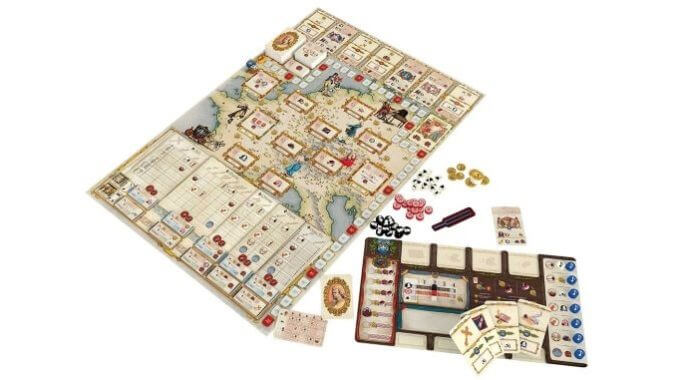The board game Lacrimosa is a stunner on the table, from the ornate drawing of Wolfgang Amadeus Mozart on the cover to the massive table presence, with a board that includes a map of western and central Europe in Mozart’s time and a facsimile of sheet music at the bottom. Fortunately, the game itself is a match for its art and table presence, with a clever deckbuilding mechanic and multi-function cards that allow for quick turns but a lot of strategy.
Players in Lacrimosa are patrons of Mozart, who left his Requiem unfinished at his death, at which point his widow Constanze contacts the patrons to help her find new composers to help complete the masterwork. The game moves backward in time, sort of, as players commission new works from Mozart, arrange to perform or sell them for cash and/or other bonuses, travel with Mozart to different cities for one-time or game-end bonuses, and hire composers and musicians to complete the Requiem. The narrative here is a little jumbled, as many of these things happen simultaneously in the game but would have required that Mozart be alive and dead at the same time, and we’ve already had one Schrödinger’s Cat-themed game this year.
I say you just go with it, because the game itself is quite good. Each player gets four actions in each of the game’s five epochs, and your actions come from your deck of nine cards. You play two cards on each turn, choosing one for its action, shown at the top of the card, and another for the resources it will give you in the next epoch, shown at the bottom of the card, placing them in top and bottom slots in your player board. You can use the Document Memories action to buy a new card for your deck, but you use it to replace the card you placed in the bottom slot on that turn, so your deck will always comprise nine cards. Another action lets you buy an Opus card, which goes on the table rather than in your deck; one action lets you perform or sell an Opus you have for cash and/or resources; one lets you move the carriage along the map, paying travel costs but getting a significant benefit or possibly a game-end victory point condition; and the last lets you place a token from your board on the Requiem space on the board, assigning a musician and a composer to that space for victory points at game-end.

Many of the mechanics in Lacrimosa appear in other games, so if you’ve played a bunch of midweight games, you won’t find much here that’s unfamiliar. The multi-function cards appear in Lost Ruins of Arnak, to name just one game with them, while removing a token from your board to unlock a bonus is a big part of Great Western Trail. There’s also an income track that you can only boost by selling opus cards or with the removal of one token from your board, although two of the Requiem sections require you to move down that track to place a token there and hire a musician. The game also has some resource management, with three different trackers on your board that reset to zero at the start of each epoch, although you can also gain resource tokens that persist from one epoch to the next.
None of this is unique to this game, but it’s the sum of the parts that makes Lacrimosa both a fun and challenging experience, without becoming too complex or work-like. Because your action and resource options are limited on each turn and in each round, you don’t have that many scenarios to work through or hold in your head—you’re going to burn more cycles deciding which four actions you’ll try to use in the round, although cards you can buy later in the game can often give you two actions for the price of one. It’s not quite an engine-builder, but has about the same amount of forward planning as a lighter engine-builder like Furnace or Gizmos. And you can tweak your deck to give yourself an extra option for one action type at a cost of one you plan to use less often.
The Opus action that allows you to perform or sell is the most interesting of all of the actions in Lacrimosa, as it distills the short-term vs. long-term gain decision into something simple enough for just about any player to grasp. The gains from selling an Opus often include moving up your income track, which is far more important early in the game, but that’s also when you’d be conceding three or even four possible chances to perform the action for more cash. The income track starts to give you victory points each round and an additional resource as well if you get high enough on the track, and at the top, you get two more victory points for any further increases, so it’s more than just a cash calculation. I don’t think you can win without some of this movement, but you can choose to focus on the income track as a core part of the strategy.
I played a full four-player game of Lacrimosa at PAX Unplugged, with all four of us new to the game, and it took a shade over two hours, but I’d say at least 20 minutes were a function of us referring to the rulebook, which isn’t that clear on multiple points. (Not least of them is the one neutral instrument token on everyone’s board, which is only explained on the very last page of the rulebook: You have to place it with your own colored token adjacent to it.) The turns aren’t long, but with four players you have 80 turns in total, so the minutes add up. It’s not as complex as it might look, or as the sheer weight of the box might imply, or, most salient of all, as the verbose rulebook might fool you into thinking. If you enjoy a medium-heavy Euro that has the look of a showstopper, Lacrimosa is worth the investment.
Keith Law is the author of The Inside Game and Smart Baseball and a senior baseball writer for The Athletic. You can find his personal blog the dish, covering games, literature, and more, at meadowparty.com/blog.

